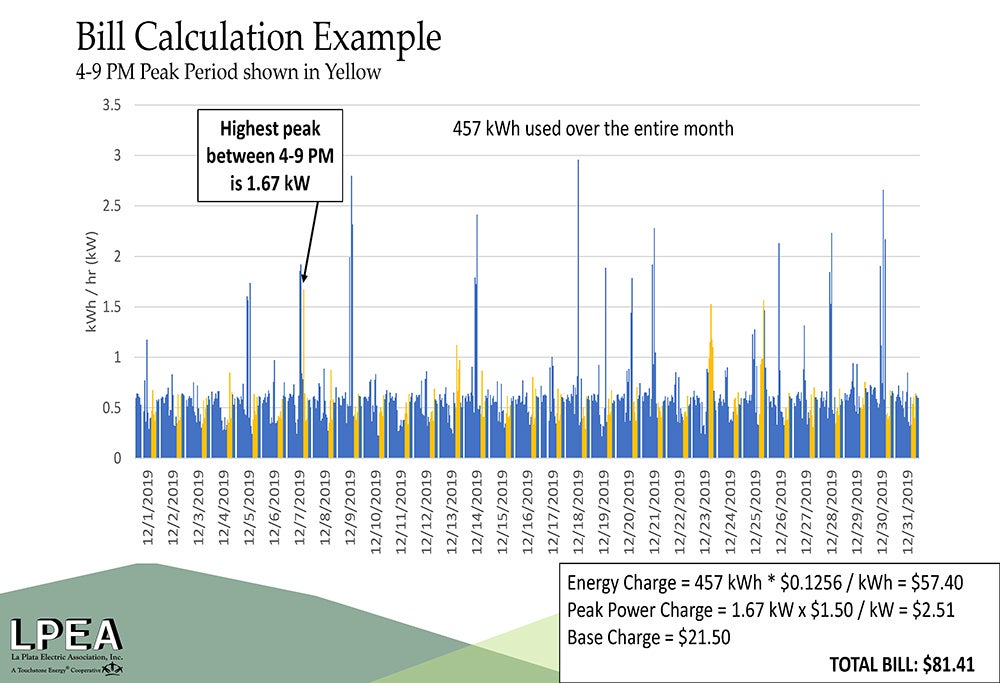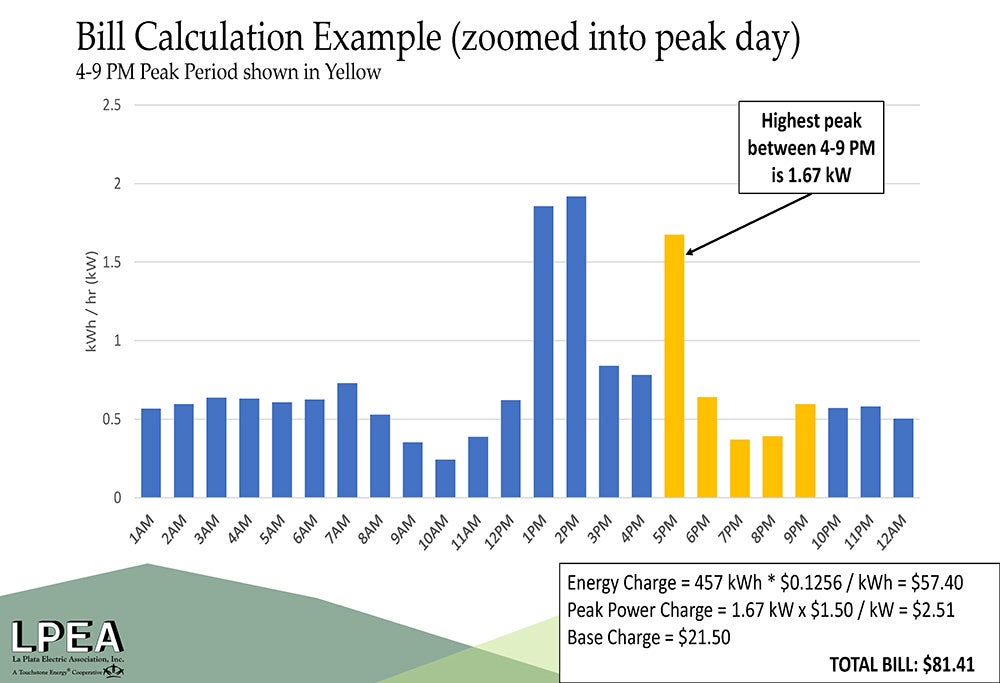
This page aims to explain how the LPEA rate structure works, why we charge what we charge, the details of the rate increase effect April 1st and how this will affect our various members.
On March 25th 2020, the LPEA Board of Directors approved a series of measures to support our members during the COVID-19 pandemic. These measures include a three-month delay of the scheduled rate increase. The 2020 rate increase will now be effective from July 1st instead of April 1st. <More details>
Q: How does LPEA determine its rates?
A: LPEA is a not-for-profit that delivers power to our members at cost. The purpose of LPEA’s 12 rate classes are to recover the cost of providing electric service to each of our different customer types. These expenses primarily consist of two components:
- The first component of each rate is the cost of delivering the power. This is determined based on the amount of infrastructure and services needed to deliver the required power from our power provider (Tri-State) to the members in each rate class. For example, LPEA’s large industrial customers pull their electric service straight from our transmission lines so their rate is lower per kilowatt hour. LPEA’s residential customers on the other hand, require more infrastructure (i.e. substations and equipment to decrease the electric voltage to usable levels), and poles and wires to deliver that electricity to each home. Accordingly, their rate is higher per kilowatt hour.
- The second component of each rate is the cost of the power itself. LPEA currently procures 95% of its power from Tri-State. About half of LPEA’s Tri-State bill is the energy charge – which is currently $0.042 per Kilowatt hour. The other half – the demand charge – is charged based on the ONE HOUR each month when LPEA’s energy demands are the highest. In industry parlance, this is referred to as “peak load”. Tri-State charges LPEA $19.34 per Kilowatt for this peak load. That is 460 times higher than what they charge for normal or “off peak” power.
That means that LPEA, and its members, can save a lot of money by spreading out our collective power usage and decreasing that peak load.
Q: Why is LPEA increasing its rates?
A: The cost of delivering power is increasing. Equipment costs are increasing, labor costs are increasing, aging infrastructure must be replaced, and electric systems must be updated to prevent outages. This rate increase will generate the $3 million in revenue needed for LPEA to keep up with these rising costs. LPEA has not raised rates since 2016 and has been unable to keep up with inflation and the increasing cost of equipment and services that an electric supplier must provide to its members.
Q: How was the amount and structure of the rate increase decided?
A: Options for the rate increase were first discussed in LPEA’s Finance and Audit Committee, composed of LPEA board members and staff. This group did a deep dive into all options during its public meeting and developed recommendations. The Chair of the Finance and Audit Committee then shared the recommendations with the full Board of Directors during their public meeting. The ultimate rate increase structure was unanimously approved by the board in January 2020 (Resolution 2020-01).
Q: How will LPEA members be affected by this change?
A: Each of LPEA’s 12 rate classes will increase between 1.8% and 4.7%. The average increase across all rates classes is 4%. While specific details of each increase vary across rate classes, one thing remains consistent: LPEA is continuing to incentivize off-peak electricity usage.
Here is a summary of how this rate increase will affect our largest member categories:
Residential and small business members:
The LPEA Board of Directors had several options in choosing how to apply the increase to this rate class:
- It could have been added to the base charge, which members cannot affect.
- It could have been added to the energy charge, which members can only affect by using less electricity, and we don’t want to limit our member’s electricity use.
- Instead, it was added in the form of a “Peak Power Charge”, which members can affect by shifting some of their electricity usage to avoid the on-peak hours from 4-9pm. LPEA’s other rate classes already have similar mechanisms to help reduce peak load.
If the average LPEA residential and small business member does everything the same as they always have, they will see their bill increase around $4.80 per month. But, if members shift some of their electricity usage to hours before 4pm and after 9pm (i.e. drying clothes, or running the dishwasher, or charging and electric vehicle), the increase will be less.
In this way, we are giving members some control in how much the rate increase impacts them directly AND, we are incentivizing the use of electricity during off peak hours, when the cost of procuring power is cheaper.
Time of Use members:
To help shave this peak load and decrease power costs for LPEA and our members, LPEA began offering Time of Use rates to members in 1990.
This optional program charges members different rates for their power based on the time of day. They are charged a higher rate during the “on-peak” hours. LPEA currently has more than 4,000 members who have opted-in to Time of Use rates, some of which save $100+ per month on their bill by shifting their electric usage.
For LPEA members currently on Time of Use rates, most everything will stay the same except the charge for electricity usage during Time of Use on-peak hours (6-9am and 5-10pm) will increase, resulting in an average 4.5% increase per month.
Time of Use members are NOT affected by the new residential Peak Power Charge. The charge for off-peak hours remains the same. In this way, LPEA is giving an ever-deeper incentive to use electricity during off-peak hours.
Net-metered members:
LPEA has roughly 1,200 members who are generating all or some of their own power needs during daytime hours, mostly through solar installations.
As with other residential members, we did not add the increase to the base charge, or the energy charge. Instead, we added the increase in the form of a Peak Power Charge, which customers can affect by shifting some of their electricity usage to avoid the on-peak hours from 4-9pm.
Q: Tell me more about this Peak Power Charge. Why are you charging it and how is it calculated?
A: LPEA is charged 460 times more for the ONE HOUR per month when our system uses the most power. That means that LPEA, and its members, can save a lot of money by spreading out our collective power usage and decreasing that peak load.
To help spread out that power usage and incentivize our members to shift some of their electricity usage to outside peak hours (4-9pm), LPEA introduced the Peak Power Charge to its residential and small business (i.e. general service) rate class. LPEA’s other rate classes already have similar mechanisms to help reduce peak load.
Similar to how TriState charges LPEA for the power we buy from them, we calculate this Peak Power Charge based on the ONE HOUR per monthly billing cycle, between the peak hours of 4-9pm, where a member uses the most electricity. We take the load during that ONE HOUR and charge $1.50 per kilowatt used.
For example, LPEA’s average member with a $105 monthly bill will see a peak power reading of approximately 3.2 kW resulting in a $4.80 Peak Power Charge. For an all-electric home with a monthly power bill of $200, the peak power reading might be 6 kW resulting in a $9.00 Peak Power Charge.
All members contribute to LPEA’s Peak Power kW (Load) and the costs associated with that. In turn, all members can help to reduce this load and cost by shifting usage away from the 4-9pm timeframe.


Q: Okay, so I understand that LPEA is incentivizing the usage of electricity during off peak times. How can I get a better understanding of how and when I am using electricity?
A: LPEA offers free access to detailed information about your electricity use, and tools to analyze and manage it, through the SmartHub Mobile and Web apps. You can access real-time usage data, manage your account, pay your bill, report issues, and set up notifications regarding your electric usage all via your phone or computer. More details https://lpea.coop/smarthub-application
Q: I still have questions. Who can I call for more details?
A: Contact LPEA’s customer service team at (970) 247-5786
